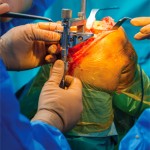Amir Atwal* is a 76-year-old man who had a knee arthroplasty six weeks ago: He wonders how he is doing in comparison to other individuals of his age at the same stage of recovery. Will you be able to provide him with an answer?
If you are looking for a one-stop shop to help you answer this and other questions related to confidently assessing impairment, function and activity in patients after knee or hip arthroplasty, check out the recently completed Total Joint Arthroplasty Outcome Measures (TJAOM) Toolkit. The TJAOM Toolkit is designed to help clinicians choose, use and interpret appropriate outcome measures for patients along the continuum of hip or knee joint arthroplasty. Developed using key concepts from the science of knowledge translation, and facilitated by the British Columbia Physical Therapy Knowledge Broker (PT KB), this project was “made possible by the passion, knowledge, skills and commitment of a multidisciplinary team of over 30 clinicians, researchers and students over a six-year period,” says PT KB Alison Hoens. TJAOM was built from the assimilation of key findings from a chart audit, focus group, survey and Delphi process, then integrated with guidelines from other arthritis initiatives focused on outcome measurements, such as those published by the Association of Rheumatology Health Professionals (ARHP) and Osteoarthritis Research Society International (OARSI).1,2
Why the Toolkit Is Important
Outcome measures are critical, not only to evaluate an individual’s current performance, but also to track progress and the effectiveness of treatment and therapies over time and across disciplines and clinical settings. Importantly, outcome measures assess the actual or perceived ability of an individual to carry out such activities as walking, dressing and completing other personal care, as well as the ability to participate in everyday activities such as work or household management.3 Standardization of outcome measures is consistently recommended to monitor progress after hip and knee arthroplasty and, if comprehensive and well chosen, can capture all domains of the International Classification of Functioning: body structure and function, activity, participation and contextual factors.4
Patients, as well as health professionals involved in their care, are interested in monitoring immediate responses to treatment, as well as longer term recovery over the entire continuum of care. Using outcome measures to evaluate the trajectory of recovery before and after surgery, we can answer clinical questions, such as: Has my patient’s function improved compared to before their surgery, and is my patient meeting important treatment milestones?


